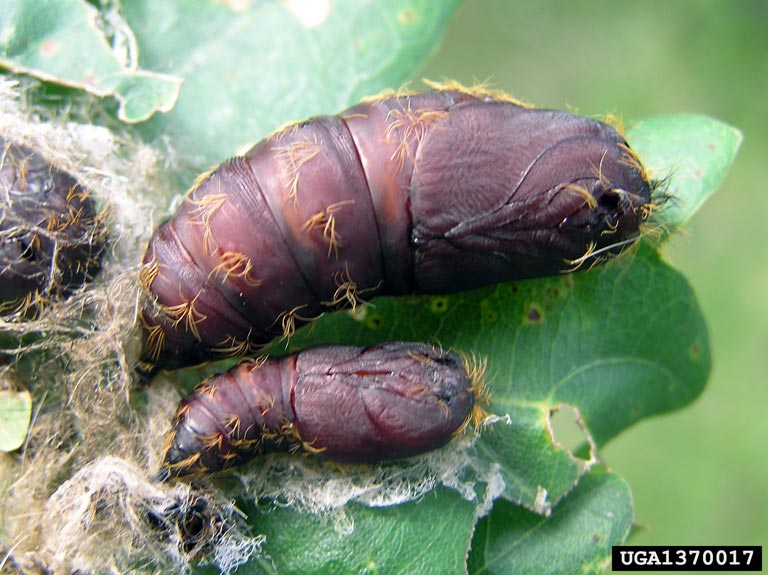
Adults are gray male or white female colored hairy moths with a 1-12 2 inch wingspan. Like many successful invasive species.

Their eggs will often live in the winter on the bark of trees but it is in the spring and early summer when the larvae climb the trees to eat on foliage.
Gypsy moth caterpillar lifespan. Male and Female Gypsy Moths. After less than a weeks time the male and female moths emerge from their respective pupa. The males are brown and fly.
They flutter around seeking a female. The females are white in color and dont fly. They crawl someplace and wait for a male to find them and mate with them such as is seen in this photo.
Gypsy moth caterpillar lifespan pdf version The European gypsy moth was introduced into this country in 1869 and occurs generally throughout most of the Northeastern United States and adjacent Canada. During favorable conditions for the gypsy moth outbreaks may appear suddenly and may continue for two to five years in any one location. Adult gypsy moths do not feed and while gypsy moths may be present for two to three weeks in a local area individual moths live only a few days.
Female moths are white with black markings. Despite their large wings female gypsy moth cannot fly. They produce a powerful pheromone that attracts the male moths for mating.
Whats the life cycle of the gypsy moth. Adult moths lay eggs toward the end of summer. The following spring usually around late April or early May young caterpillars emerge.
Thats when they begin feeding. After eating your trees for about a month the caterpillars rest in their pupal cases. Only the caterpillar stage of the gypsy moth feeds.
When fully grown they will be approximately 2 inches long very hairy and have five pairs of blue dots followed by six pairs of red dots along its back. Adults are gray male or white female colored hairy moths with a 1-12 2 inch wingspan. Although both sexes are winged the female moth does not fly.
The gypsy moth caterpillar has a major outbreak every 7 to 10 years and early signs are that this is going to be a bad year for them. Many of the control methods need to be started when the caterpillar is still small and before they do much damage to. The Gypsy Moth caterpillar Lymantria dispar.
The Gypsy Moth Lymantria dispar is also known as the North American Gypsy Moth and the European Gypsy Moth. The species is best known for the damage the caterpillars do to deciduous forests in many different parts of the world. In the US it is a particular pest of trees in eastern states.
Lymantria dispar dispar commonly known as the gypsy moth European gypsy moth or North American gypsy moth is a species of moth in the family Erebidae that is of Eurasian origin. It has a range that extends over Europe Africa and North America. Carl Linnaeus first described the species Lymantria dispar in 1758.
Each gypsy moth outbreak typically lasts two to three years. These outbreaks generally cycle out through natural factors such as viruses and funguses that kill off excessive numbers of the gypsy moths. DEC has no plans in place for action against the infestation as the most effective time window to deal with the gypsy moth caterpillars has passed.
A serious threat to trees and shrubs in North America the gypsy moth Lymantria dispar is an insatiable eaterone fully grown caterpillar can eat up to a square foot of tree leaves in just one day. This defoliation process can significantly damage a tree and if the infestation is bad enough strip the entire tree of leaves within a. Unlike many other moths and butterflies the adult gypsy moth cannot feed.
They have about 2 weeks to find a mate before they die. Once the male has found the female they mate and the female lays all her eggs in a single teardrop-shaped mass 1 15 inches long and covers it with yellowish-tan colored hairs from her own body. The only function of the adult stage of the gypsy moth is to reproduce leaving behind as many as a thousand descendants.
Unlike many other moths and butterflies the adult gypsy moth cannot feed. The moth has about 2 weeks to find a mate before death. Completing their one year life cycle.
Will I have to deal with gypsy moth next year. Gypsy moth populations typically remain high for two to three years then collapse and return to low levels. This population collapse usually is the result of a virus disease called NPV that affects gypsy moth caterpillars.
Their eggs will often live in the winter on the bark of trees but it is in the spring and early summer when the larvae climb the trees to eat on foliage. Like many successful invasive species. The gypsy moth Lymantria dispar is a non-native insect from France.
In New York gypsy moth caterpillars are known to feed on the leaves of a large variety of trees such as oak maple apple crabapple hickory basswood aspen willow birch pine spruce hemlock and more. Oak is their preferred species. Gypsy Moth Caterpillar Identification.
Gypsy moths are an invasive species that can destroy entire forests. It is critically important to control their spread. If you have found caterpillars that you think might be gypsy moths this identification guide can help.
The photos in this guide show you exactly what these destructive caterpillars look. What happens when the caterpillars become moths. Luckily we wont have to worry about the moths bothering us too much.
According to Darling the moths will come out around July fly around a bit mate and and then die the females lay their eggs first and then they die.